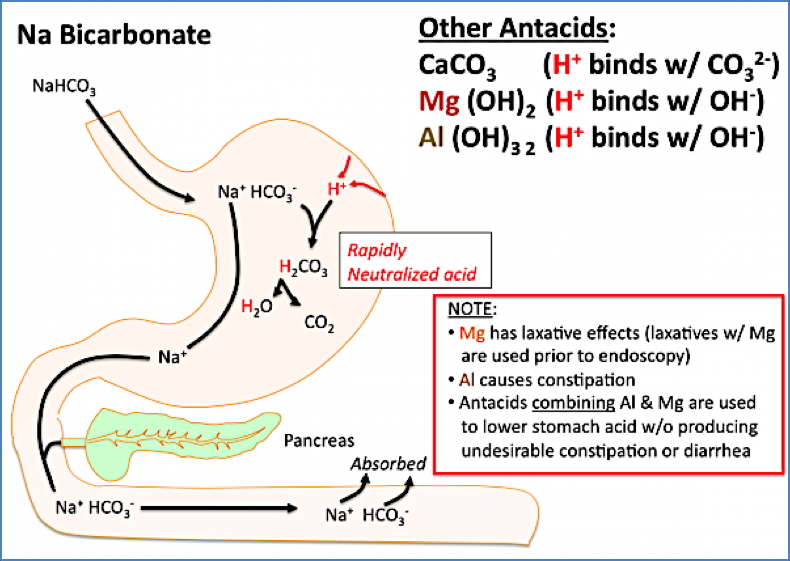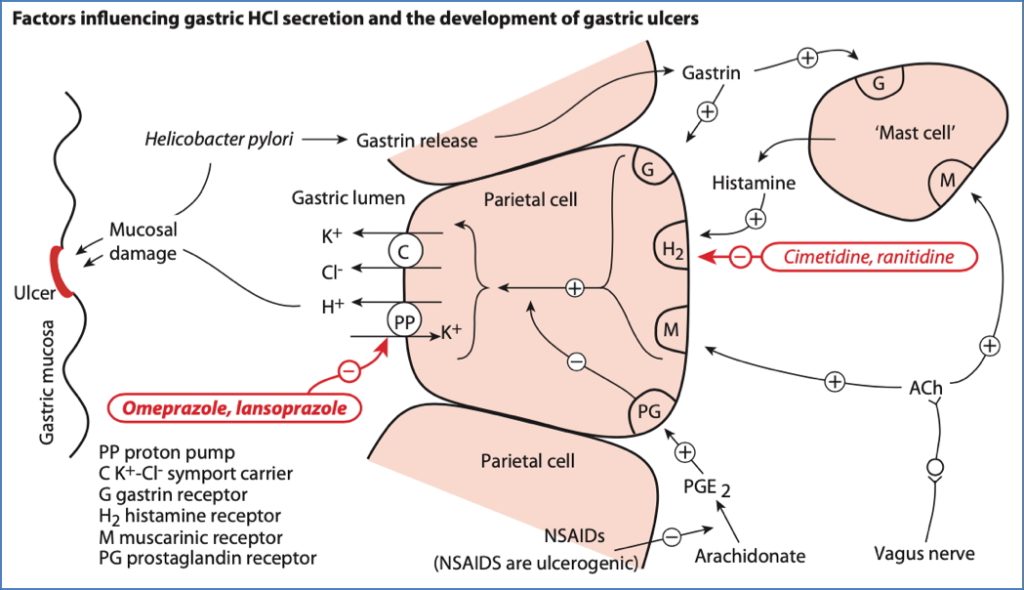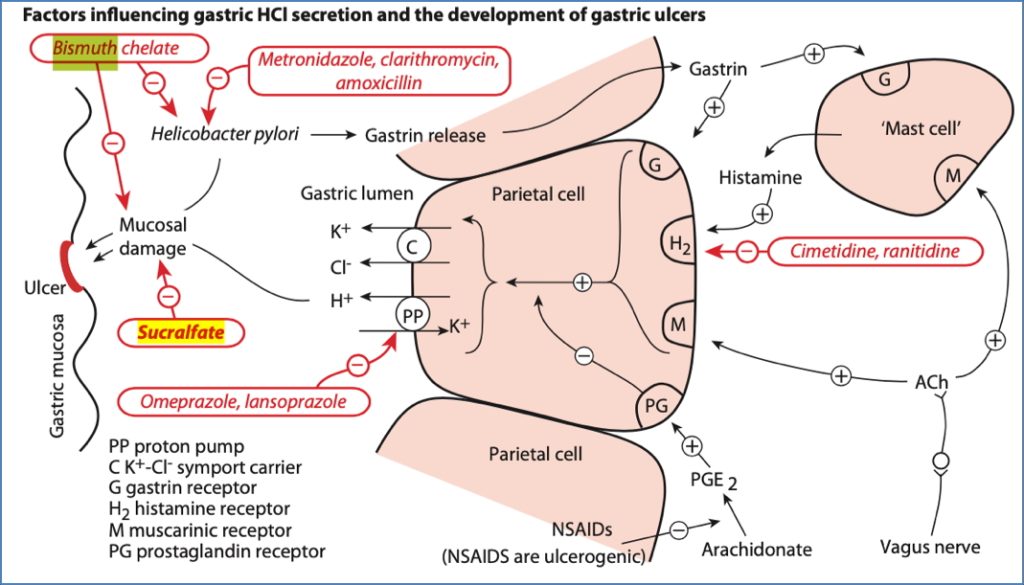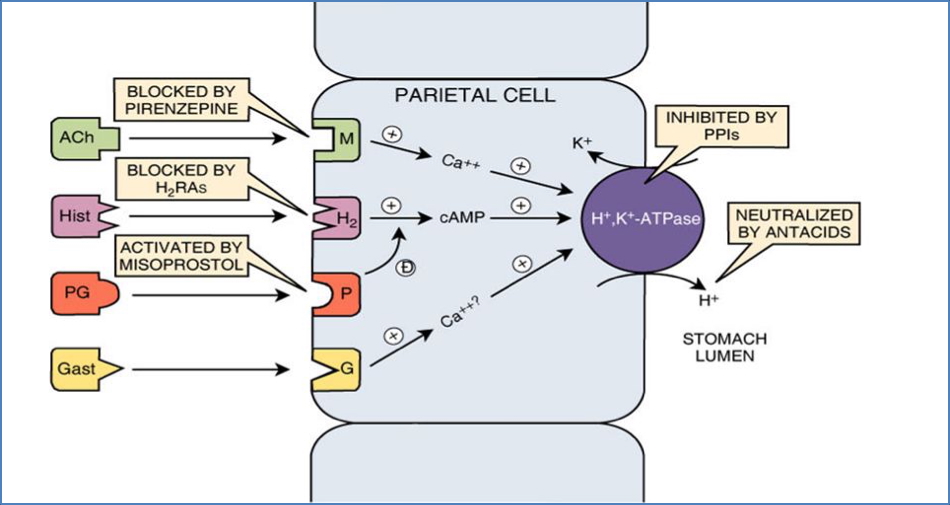Table of Contents
Overview – Antacid Drugs
Antacid drugs are used to treat gastric acid–related disorders such as gastroesophageal reflux disease (GORD/GERD), dyspepsia, and peptic ulcer disease. Treatment options include direct acid neutralisers, acid secretion inhibitors, and cytoprotective agents that enhance mucosal defences.
1. Acid Neutralisers
Antacids
Mechanism of Action:
- Directly neutralise gastric acid in the stomach lumen
- Provide symptomatic relief in acid reflux and indigestion
Common Antacid Ingredients:
- Aluminium salts (e.g. Al(OH)₃)
- Calcium salts (e.g. CaCO₃)
- Magnesium salts (e.g. Mg(OH)₂)
- Sodium bicarbonate (NaHCO₃)
- Magnesium-Aluminium combinations → balance bowel effects
Side Effects:
| Compound | Common Side Effects |
|---|---|
| Aluminium Salts | Constipation, Al+ accumulation (renal impairment), hypophosphataemia |
| Calcium Salts | Constipation, rebound hyperacidity, milk-alkali syndrome |
| Magnesium Salts | Diarrhoea, Mg+ accumulation (renal impairment) |
| Sodium Bicarbonate | Milk-alkali syndrome, avoid in sodium-restricted patients |
| Mg-Al Combos | Minimise GI effects (balanced bowel effects) |

Alginates
Mechanism of Action:
- Increase mucus viscosity and adherence to oesophageal mucosa
- Form a protective barrier that prevents acid reflux
- Often combined with antacids
Side Effects:
- Bloating → altered eating behaviour
- May affect absorption of oral drugs via pH alteration
2. Inhibitors of Acid Production
H₂ Histamine Receptor Antagonists
Mechanism of Action:
- Block H₂ receptors on parietal cells
→ ↓ cAMP → ↓ gastric acid secretion
Classical Agents:
- Ranitidine
- Cimetidine
- (Also: Nizatidine, Famotidine)
Side Effects:
- Diarrhoea
- Dizziness
- Muscle pain
- Alopecia
- Rash
Proton Pump Inhibitors (PPIs)
Mechanism of Action:
- Prodrug activated in acidic environment
- Irreversibly inhibits H⁺/K⁺ ATPase (proton pump)
→ Profound acid suppression
Classical Agents:
- Omeprazole
- (Also: Esomeprazole, Lansoprazole, Pantoprazole, Rabeprazole)
Side Effects (Uncommon):
- Headache
- Diarrhoea
- Rash

3. Cytoprotective Agents
Bismuth-Chelate
Mechanism of Action:
- Coats ulcers, adsorbs pepsin
- Directly toxic to Helicobacter pylori
- Enhances local prostaglandin synthesis → ↑ mucus, ↓ acid
- Stimulates bicarbonate secretion
Side Effects:
- Nausea, vomiting
- Black tongue/feces
Sucralfate
Mechanism of Action:
- Strong negative charge → binds to proteins → forms physical gel barrier
- ↓ diffusion of H⁺ through mucus
- Enhances prostaglandin production, mucus & bicarbonate secretion
Side Effects:
- Constipation
- Dry mouth, headache, nausea

Misoprostol (Prostaglandin E1 Analogue)
Mechanism of Action:
- Stimulates PGE₂ receptors:
- Goblet cells → ↑ mucus
- Parietal cells → ↓ acid
- Increases mucosal blood flow
- Enhances mucus & bicarbonate secretion
Side Effects:
- Diarrhoea
- Abdominal cramps
- Contraindicated in pregnancy (can induce uterine contractions)

Summary – Antacid Drugs
Antacid drugs and related agents offer multi-pronged treatment for gastric acid-related conditions. While antacids neutralise acid directly, H₂ antagonists and PPIs inhibit acid production, and cytoprotective agents bolster mucosal defences. Choosing the right agent depends on the underlying pathology and patient-specific factors such as renal function and pregnancy status. For a broader context, see our Pharmacology & Toxicology Overview page.